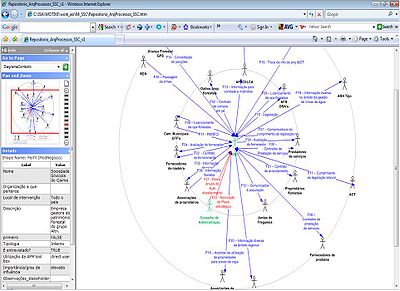Forest multi-decision maker regional planning at the Portuguese Chamusca County
General case description
Brief overview
The project aims forest decision-making analysis at regional level, applied to the Portuguese Chamusca County case study. Several types of stakeholders took part in workshop meetings for specific decision-making processes characterization, applying an adaptation of the Enterprise Architecture (EA) methodological approach. The subsequent integrated analysis identifies required decision-making tools and enables the Integrated Forest Management Toolbox Platform (iFMtoolbox) functional specification.
Contents
Organization
The project is conducted by ISA [[1]] as part of the EU project Motive [[2]]. Stakeholders are involved across the entire iFMtoolbox specification. The participation process occurs from July 2009-Jul2010 and was organized in several workshop meetings with all regional stakeholders [1]:
- It started with selection of the key-stakeholder, who was the regional contact point responsible for contacting all other stakeholders. They were selected in the course of a brainstorm meeting with the key-stakeholder. They all took part in a collective project kick-off meeting.
- The individual 2-days specification workshop meetings are conducted by an EA skilled facilitator, who applies the “Port-IT method” for drawing the top-down hierarchical process architecture, starting with the collective context diagram, the stakeholders’ decision-making overall model and the forest decision-making process flowcharts.
- The stakeholder process architecture report (word and HTML format) is produced and validated. It is automatically generated by the VISIO drawing tool, which supports all representations and structures the collected data into pre-defined templates.
- The integrated decision-making models and project conclusions are systematized and discussed in the course of workshop meetings with the key-stakeholder. They are further discussed with all the involved stakeholders in a project ending meeting.
The project team includes:
- 1 team leader responsible for project management and stakeholders contacts (10% allocation)
- 1 EA expert performing workshop meetings facilitation and documents validation (50% allocation)
- 1 EA assistant following all workshop meetings and producing the correspondent Process Architecture reports (75% allocation)
Problem structuring
The problem of forest multiple decision-making at regional level was defined in the course of the project throughout stakeholders’ involvement in several workshop meetings following the the EA approach.
Intelligence
Stakeholders
The stakeholders list encompasses 32 participants from 22 entities, grouped into 4 categories, as presented in the table below.
| Category | Group | NºEntities | Nº participants |
|---|---|---|---|
| Private sector | FO - Forestland owner | 8 | 8 |
| FOA - Forestland owners associations | 1 | 3 | |
| FOF – Forestland owners federations | 2 | 2 | |
| FIO - Industrial Owner/Forest-based company | 2 | 3 | |
| FSP - Forest Service Providers | 1 | 1 | |
| FIF - Forest Investment Imobiliary Fund | 1 | 2 | |
| Public sector | Mun - Municipality | 2 | 2 |
| FA - Forest Authority | 2 | 5 | |
| LC - Parish (local communities) | 1 | 3 | |
| Non-Government organization | NGO - Non-Government Environment organization | 1 | 1 |
| Research Agencies | FRC - Forest Research Center | 1 | 2 |
The regional FOA - ACHAR [[3]] - was selected as the key-stakeholder. The other stakeholders were selected in the course of a brainstorm meeting with ACHAR. All the stakeholders entities were invited to participate in the project kick-off meeting. Afterwards, they selected their representatives that best fit into the workshop meetings objectives. The workshops scheduling was mainly conducted by ACHAR.
Information
According to the EA methodology approach [2], the workshop meetings draw the process architecture hierarchical representations and describe the following artifacts:
- Entities/roles
- Decision-making processes
- Activities performed
- Data flows and information attributes, required and produced by the activities
All artifacts are supported in a MS VISIO-based tool, developed specifically for this project. This tool enables automatic HTML repository generation and pre-defined word templates generation, which are used to produce the Process Architecture report.
Design
A hierarchical top-down stakeholders forest decision-making process architecture was adopted. It encompasses the Context Diagram, the decision processes overall model and the decision processes flowcharts, drawn according to the BPMN standard [[4]]. The future DSS data model and modular components complete specification emerge from the process architecture, according to the Enterprise Architecture methodological approach. Additionally, the decision processes are a useful baseline for organization strategic decision-making, working procedures definition and adoption of process-based certification schemas.
Choice
This public participatory process does not involve a Choice phase.
Monitoring
The stakeholders opinions on the project activities and results are gathered in the several workshop meetings and during the stakeholders validation phase based on the process architecture report. They will also be responsible for DSS testing phase, where the DSS implemented functionalities are matched against specifications. Additionally, the DSS relevance and its models adequacy to real-life situations can be evaluated throughout cost-benefit analysis performed by the users. No specific success criteria were monitored.
References
Cited references
- ↑ Marques, A. F., Borges, J.G., Pina, J.P., Lucas, B., Garcia, J. 2009. A participatory approach to design a regional forest management planning decision support toolbox. European Journal of Forest Research(prep)
- ↑ Marques, A. F., Borges, J.G., Sousa, P., Pinho, A., 2009. PulpWood Supply Chain Architecture. An application in Portugal. European Journal of Forest Research (submitted)
